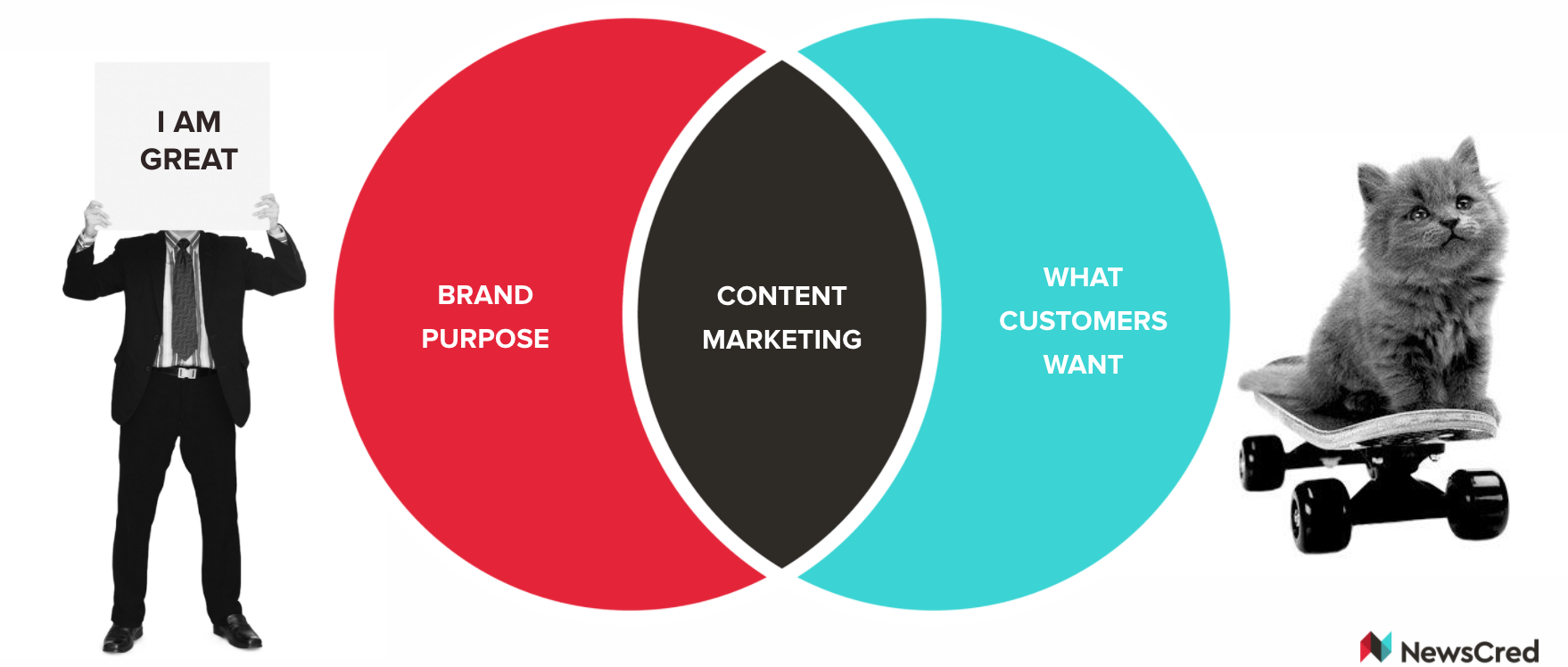Blog #1: How an Effective Digital Marketing Can Greatly Affect Your Business
Why do we need digital marketing?
For the past decade, buying behaviors of consumers have changed dramatically, due to changes of the industry, market, economy, society, and other effects as well. This shift in the way that consumers make purchasing decisions and buy products and services has made digital marketing a must for any business that’s trying to compete in the modern marketplace, regardless of size or industry.
Since nowadays, search engine has served as tool for people to look for anything I need, it has become a big deal for marketers to do marketing of their business online. It’s important for business owners to understand how digital marketing works so that they can strategically use the right digital tools and campaign tactics to reach and engage their audience.
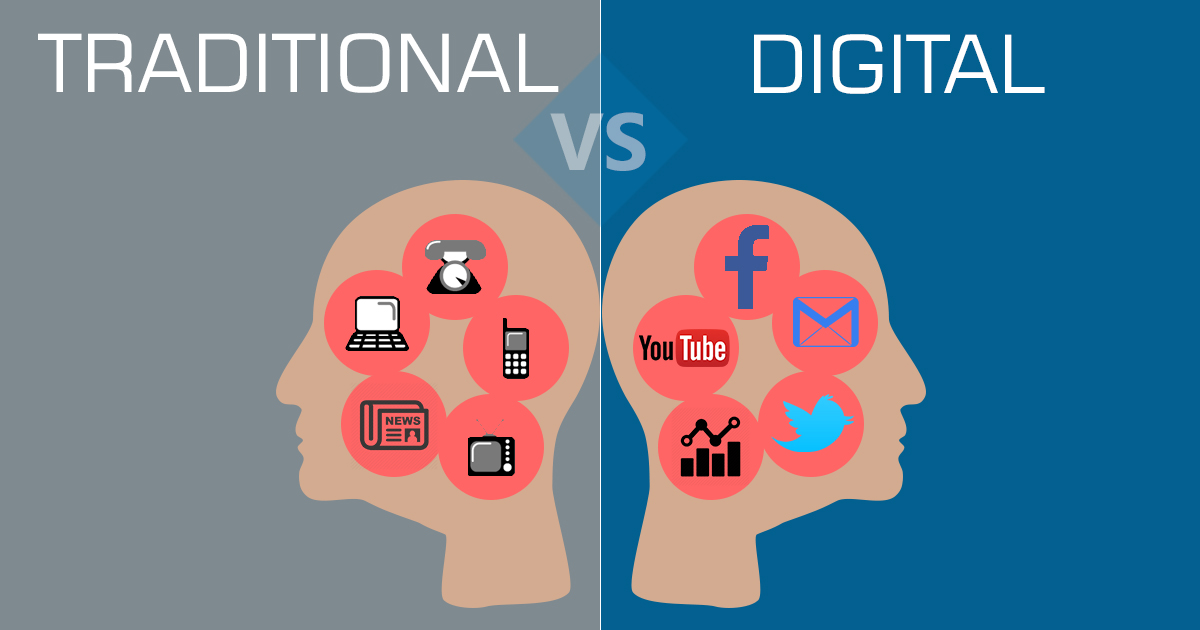
Now, what is digital marketing?
Do define the term, first, you should know what marketing is. At a fundamental level, marketing is the process of understanding your customers, and building and maintaining relationships with them. In other words, marketing is the key to an organization’s success, regardless of its size. There are several types and sub-types of marketing, but to simplify them, there are two categories of marketing type, which are digital and offline. An effective manager or business owner should determine and pursue the ones that work best for their business.
Each category of marketing has its own strengths and weaknesses; however, knowing which one works best for a business will help to make the marketing campaigns become much more effective. For digital marketing, it is a way to promote brands and products online and through other digital channels. Most businesses have a specific audience they are trying to reach, and digital marketing aims to help businesses reach these target consumers through the internet and other digital avenues.
There are a number of different digital technologies that marketers and companies use to get their marketing message to their target audience. In addition to their website, a company might also use PPC and display ads, email marketing, mobile technology like smartphones, social media, and other mediums to attract and engage their target consumers.

How digital marketing can help businesses?
Digital marketing is vital for modern businesses because the internet plays a significant role in how today’s consumer makes purchasing decisions. The internet also impacts how consumers actually purchase their products and services. This makes it imperative for businesses to not only be present online but to boost visibility as much as possible.
The days of browsing at a physical store location and asking sales associates for more information about products are no longer happening. On these modern days, consumers use the internet to get the information they need to make an informed purchasing decision, even if they still visit the physical store location to make their final purchase.
That’s where digital marketing comes in. It helps your business reach these consumers wherever they are in their digital buyer’s journey. Thus, knowing about digital marketing and being able to use it effectively will greatly change and improve a business’s growth.
Blog #2: Power of Website Marketing
What are the technologies of digital marketing?
Digital marketing can come in handy and effective for businesses in many forms. They can be found on websites, online advertisements, social media posts, online campaigns, pop-up advertisements, etc.
It’s important for business owners to understand how digital marketing works so that they can make smarter decisions about their digital marketing campaigns. The key to understanding how it all works is getting to know each element of digital marketing and recognizing how each can help you reach your marketing goals.
Website Marketing
The majority of consumers these days are tech-savvy and usually their first exposure is through your website. Word of mouth, social media, or a search engine may be how they first hear of your company’s existence, but ultimately, most consumers will explore a website before visiting a business in person. If your website is not consumer-friendly, or difficult to find, you are turning valuable consumers back to your competition. When a potential customer comes across your website, make sure they are met with a great first impression.
In many ways, your company’s website is the cornerstone of your digital marketing strategy. This is where many of your target customers first get an impression of your brand, and more often than not, this is where your leads will eventually convert into paying customers.

The goal of digital marketing is to attract, engage, and convert your leads. Many of the tactics that you will use to do this will ultimately lead your target customers back to your website to get more information or make a purchase.
Appearance of Website
Your website is sometimes your brand’s only chance to make a good first impression with consumers in your target market. For this reason, you should pay attention to the layout of your site as well as the colors and graphics that you use in your site design. In fact, according to Adobe, 38% of people will stop engaging with a website if they find the content or layout to be unattractive.
However, the appearance of your site is not the only thing that matters. Since your website is the center of many of your digital marketing campaigns, it’s important that it is designed and optimized for conversions. This means creating a site that is easy to navigate and read with clear guidance for the next steps consumers need to take to move further down the funnel. This also means creating a site that optimized for mobile devices to improve the mobile user’s site experience.

Using Website as a Reflection of Brand
In today’s technology-centered world, your website, being the center of your strategy will have branches that extend out to your email, social media, ad campaigns, etc. In each strategy session, your brand and message need to be emphasized and explained.
However, unfortunately, many of business owners make a huge mistake in their marketing strategies. They do not focus on developing their brand while doing marketing, which means they are giving the opportunities of being ahead of their competitors away.
Often, your website will include links to your social media pages while your social media posts will drive traffic to your website.
Your website will be sending emails with a subscription form to your email marketing software.
Your print ads in magazine might have a prepared message that, when people access your website it should match the print ad with the same message. Maybe even more specific and include the same photo, text, etc.
![]()
Basic questions that one should ask to know if it’s an effective website for business:
- Does your website represent your brand?
- Does your website’s content emphasize your brand’s message?
- Is it interactive and inviting?
- Can the visitors find the information they need?
- Is the website mobile friendly?
Of course, there are more questions that one should ask to really have their website running effectively with high turnovers for the business. However, being able to answer these questions will help you determine if your website is at least good enough for the visitors to visit and know about your brand.
Blog #3: The Importance of Content Marketing
What is content marketing?
To view content marketing as a subject, you should simply first understand it as the education for your audience about your brand , not a promotion. To define specifically, content marketing is a strategic marketing approach focused on creating and distributing valuable, relevant, and consistent content to attract and retain a clearly defined audience, and ultimately, to drive profitable customer action.
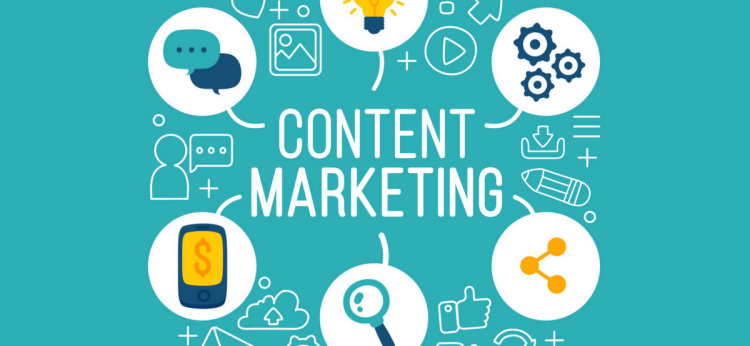
How important is content marketing to your business?
Content marketing is an important tactic, which plays a significant key in how digital marketing works. Content marketing becomes very essential especially when your business creates and promotes certain content assets that are aimed at attracting and engaging your target customers from a segment. These content assets specifically can be created for a number of different purposes, including developing brand awareness, increasing site traffic, boosting leads, or maintaining customers.
Content marketing is very important and necessary, since no matter which tactics that you use for your digital marketing strategy, you will still need to create content to support these tactics.
The content can be something short and simple as a thank you email to someone who has subscribed to your email list, or it can be a longer, more detailed like an e-book, that explains and emphasizes all the information about one of the biggest challenges that your target customers face.
3 main benefits of creating powerful content marketing:
Technically, there are three key and benefits, and also reasons, for businesses to use content marketing:
- Increasing sales
- Saving costs
- Attracting customers with high brand loyalty
These benefits absolutely should be reasons for why you need great marketing content. Effective marketing content does not only increase your profit, but also cut back on your expenses, and developing brand loyalty for your customers as well.
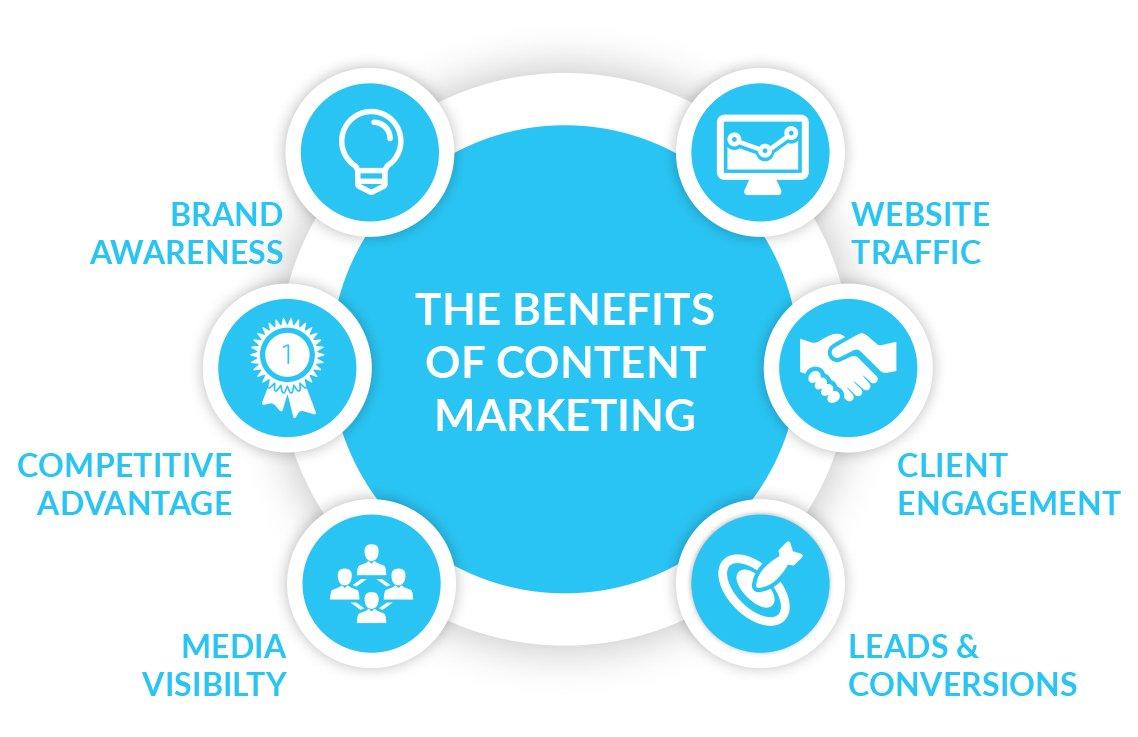
Some types of content marketing that are usually used for digital marketing campaigns:
- Website pages
- Blog posts
- Social media posts
- E-books
- White papers
- Case Studies
- Testimonials
- Videos
- Images
- Info graphics
- Podcasts
- Ad Content
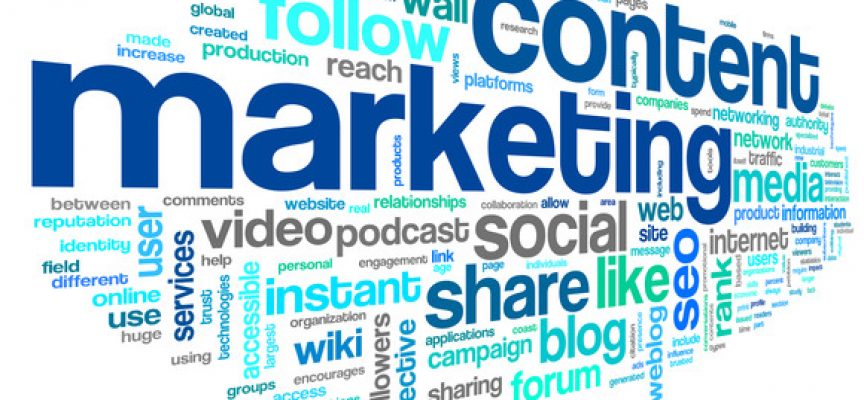
Quality content is part of all forms of marketing:
- Social media marketing: Content marketing strategy comes before your social media strategy.
- SEO: Search engines reward businesses that publish quality, consistent content.
- PR: Successful PR strategies address issues readers care about, not their business.
- PPC: For PPC to work, you need great content behind it.
- Inbound marketing: Content is key to driving inbound traffic and leads.
- Content strategy: Content strategy is part of most content marketing strategies.
How to create powerful and useful marketing content
The key to creating great content assets that help support your digital marketing campaigns is strategically choosing topics that appeal most to your audience. If you haven’t already, make sure that you do some target audience research and even create customer personas to ensure that you know your customers well and can identify what types of content will attract and engage them at each step in the buyer’s journey.

Blog #4: Social Media Marketing
How can one define social media marketing?
Social media marketing is a form of internet marketing that involves creating and sharing content on social media networks, in order to achieve your marketing and brand promoting goals. Social media marketing includes many activities like posting text, image updates, videos, and and other content that drives audience engagements, as well as paid social media advertising.

How can social media marketing help your business’s marketing project overall?
Social media marketing can help with a number of goals, such as:
- Increasing website traffic
Without marketing your business on social media, your inbound traffic is limited to your usual customers. The people familiar with your brand are likely searching for the same keywords you already rank for. Without utilizing social media as part of your marketing strategy, you’ll have much more difficulty reaching anyone outside of your loyal customer circle.
Every social media profile you add to your marketing mix is a gateway to your website, and every piece of content you post is another opportunity to acquire a new customer. Social media is a melting pot of different types of people with varying backgrounds and behaviors. With different people come different needs and different ways of thinking.
Syndicating your content on as many platforms as possible allows these individuals to organically reach your business. By marketing on social media you can effectively open your business to a wider variety of versatile consumers all over the world.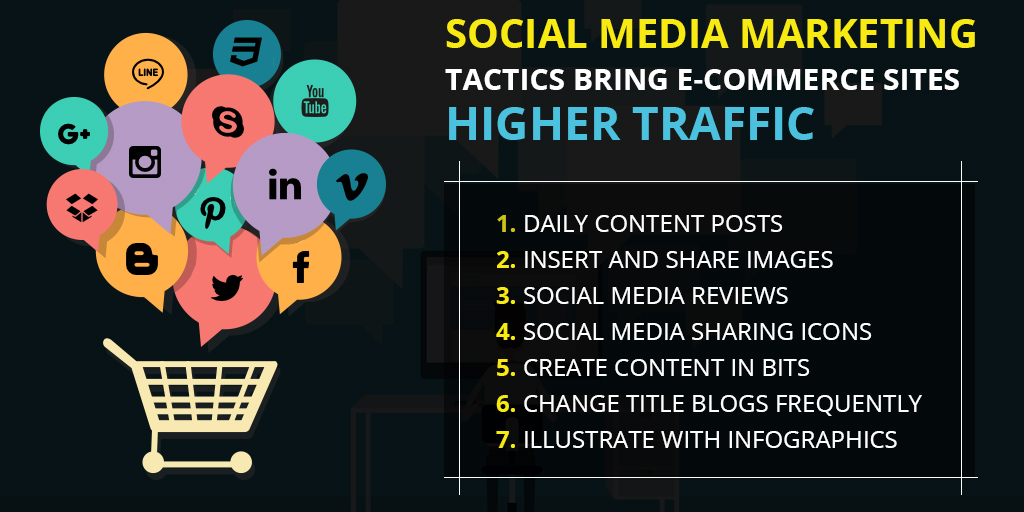
- Building conversions
With increased visibility, your business gains more opportunities for conversion. Every blog post, image, video, or comment may lead viewers to your company’s website and increase traffic. Social media marketing allows your business to give a positive impression through a humanization factor. When brands are interactive by sharing content, commenting, and posting statuses on social media, it personifies a brand.
The better impression you make on a visitor, the more likely they are to think of your business when the need for your product or services arises. When a brand is interactive online, consumers who follow your brand’s accounts often begin to more completely trust the credibility of your business.
More likely than not, they’ll mention your brand to a friend when your products or services are needed, overall providing your business with social proof of its quality. Putting your brand in an atmosphere where people are sharing, liking, and talking, can only improve the conversion rates on your existing traffic.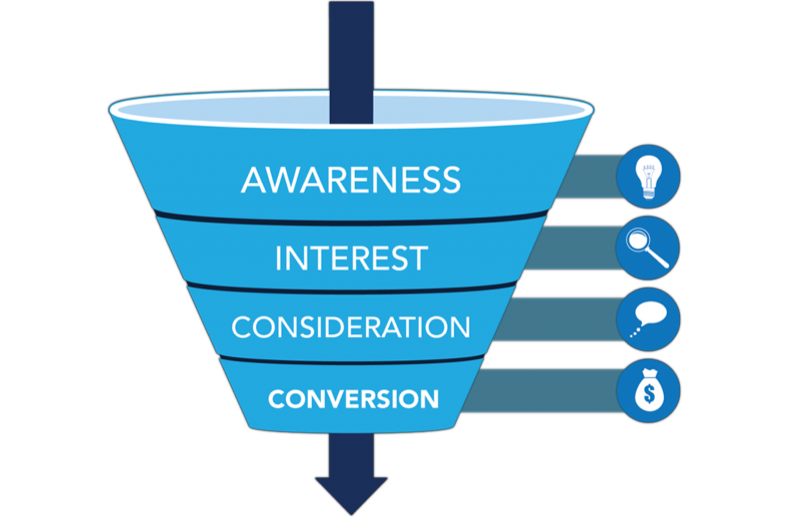
- Raising brand awareness
Social media is one of the most cost-efficient digital marketing methods used to syndicate content and increase your business’ visibility. Implementing a social media strategy will greatly increase your brand recognition since you will be engaging with a broad audience of consumers.
To get started, create social media profiles for your business and begin interacting with others. Get employees, business partners, and sponsors to “like” and “share” your page. Simply having people interact with your content will increase brand awareness and begin building your reputation as a business. Each post that is shared will be introduced to a new network of individuals, which can lead them to becoming potential customers, and the more people who know about your business, the better. There is no doubt that by simply having a social media page your brand will benefit, and with regular use it can generate a wide audience for your business.
- Creating brand loyalty
One of the main goals of almost all businesses is developing a loyal customer base. Considering that customer satisfaction and brand loyalty typically go hand in hand, it is important to regularly engage with consumers and begin developing a bond with them. Social media is not just limited to introducing your brand’s products and promotional campaigns.
Customers see these platforms as a service channel where they can communicate directly with the business. Since these technology natives require communication with their brands, businesses must implement social media marketing to get the attention of their most influential consumers.
- Cost effectiveness
Social media marketing is the most cost-efficient part of an advertising strategy. Signing up and creating a profile is free for almost all social networking platforms, and any paid promotions you decide to invest in are a relatively low cost compared to other marketing tactics.
Being cost-effective is such an advantage because you can see a greater return on investment and retain a bigger budget for other marketing and business expenses. Just by spending a small amount of time and money you can significantly increase your conversion rates and eventually get return on investment on the money you initially invested.
Blog #5: The Significance of Pay Per Click Advertising
What does Pay Per Click (PPC) advertising mean?
Pay Per Click advertising (PPC) is a model of advertising that allows marketers to pay only when their ad is clicked by an online user. Search engines like Google and Bing make pay per click advertising available on an auction basis.
To show an ad on a search engine results page, for instance, Google, marketers create ads and then bid on specific search phrases for which to show them. These pay per click ads will then appear above and below the non-paid organic search results, and you’ll pay the search engine for every time a user clicks on your ad, regardless of the total number of times the ad was shown.

Why is PPC advertising so significant to business owners?
Although search engine optimization is important, it takes a long time to start working effectively. This is when PPC advertising comes in handy. Fortunately, PPC advertising can help you see results more quickly by putting your site at the top of the search engine results page for relevant search terms. By appearing on the first page of the search results, your business gains new visibility, and searchers are more likely to find and click on your site.
PPC ads not only generate more traffic to your site, but they can help you ensure that the leads you are getting are qualified. Those who are clicking on your PPC ads are consumers who are searching for the topics that are most relevant to your products or services. This means that they are more likely to be interested in your brand and the products or services that you provide.
Also, PPC advertising is very fast. With some systems, such as Google AdWords, you can generate targeted traffic within a few minutes of opening an account.

How PPC advertising can also be challenging
PPC advertising can run up costs extremely quickly. It’s easy to get caught up in a bidding war over a particular keyword and end up spending far more than your potential return. Being number one on the top results of a searching page can cost thousands and thousands of dollars. Also, bid inflation consistently raises the per-click cost for highly-searched phrases.
Junk traffic can also affect your campaign negatively. While you certainly want your ads displayed on Google or Bing, you may not want your ads showing up and generating clicks from some of the deeper corners of the Internet. The resulting traffic may look fine in high-level statistics reports, but you have to separate out partner network campaigns and carefully manage them.
Finally, pay per click advertising does not offer economies of scale. If you get more traffic, you pay more money in nearly direct proportion to that traffic. Thus, your cost per click stays constant, and your overall cost increases.
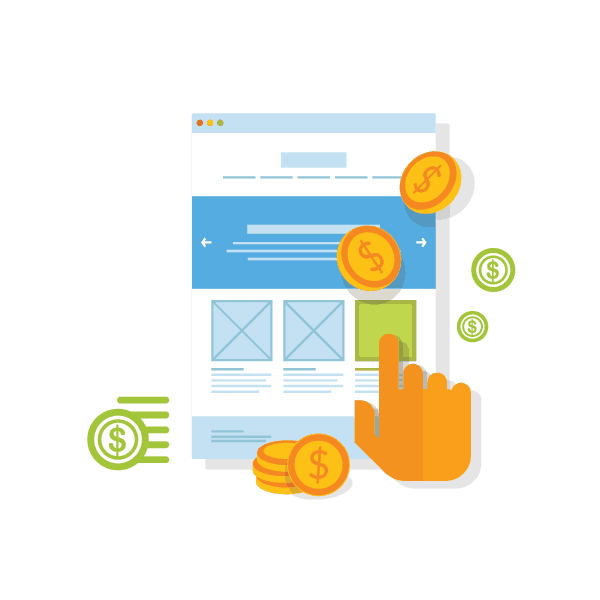
Blog #6: Email Marketing
What is email marketing?
Email marketing is basically the use of email to promote products or services. However, to deepen the meaning with better email marketing definition, it is the use of email to develop relationships with potential customers or clients.
Companies can use branded emails to communicate with their target audience. Marketing emails are often used as a way to increase brand awareness, establish industry leadership, promote events, and get the word out about special promotions.
Email marketing is one segment of internet marketing, which encompasses online marketing via websites, social media, blogs, etc. It is essentially the same as direct mail except that instead of sending mail through the postal service, messages are sent electronically via email.
It’s important to note that email marketing is mainly used not for generating new leads, but rather nurturing leads once they have shown interest. Marketing emails can also be used as part of your customer retention campaigns.

Advantages of email marketing
- Permission based – your marketing list will be made up of people who have agreed to receive emails from you. Customers who are genuinely interested in your products or services are more likely to engage with your business.
- Flexible design – you can send plain text, graphics or attach files – whichever suits your message best.
- Scalable – email marketing can be used to reach large audiences or smaller targeted lists.
- Personalization and segmentation – with email marketing you can personalize messages. You can also segment your marketing list, and this will help boost the engagement of the customers with you.
- Shareable – it’s easy for people to forward and share your email advertisement, building your reputation of viral marketing. This may help influence potential customers to become followers of your brand.
- Conversions and increased sales – if you have a new promotion, people can click on links and follow your call to action immediately. Email marketing is also effective at every stage of the buying process.
- Measurable – you can evaluate the success of a campaign by using web analytics software.
- Less intrusive – unlike telephone marketing, recipients can read your message at a time that suits them.
- Cost effectiveness – the costs of email marketing can be much lower than many other forms of marketing. There are no advertising fees, printing or media space costs.
- Environmental friendly – email marketing is better for the environment because nothing is printed.
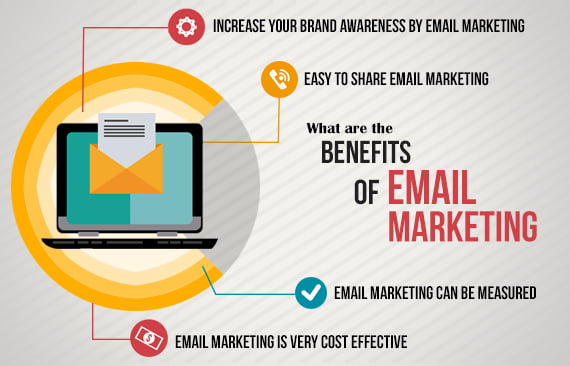
Disadvantages of email marketing:
Some of the potential problems of email marketing include:
- Spam – spam emails irritate consumers. If your messages aren’t targeted to the right people, the recipient may delete your email or unsubscribe. You need to make sure that your email marketing complies with privacy and data protection rules, and that it is properly targeted at people who want to receive it.
- Undelivered emails – Emails that use certain spam keywords in the subject heading or content of the email are likely to be filtered out by email software and internet service providers. If you don’t keep your marketing lists up to date, you will find incorrect email addresses mean your messages won’t reach the right person.
- Design problems – Your email must be designed so that it appears as it should across multiple devices and email providers.
- Size issues – files need to be small enough to download quickly. Emails containing many images may take too long to load, losing your audience’s interest.

Few types of email marketing content you might develop to support your digital marketing campaigns:
- Send a welcome email when new users subscribe to your marketing email list.
- Deliver promotional content about upcoming sales and discounts straight to the consumer’s inbox.
- Develop a newsletter that goes out to subscribers periodically to deliver the latest content and updates from your business.
- Email leads after they have downloaded content from your site to thank them for their interest, and even recommend additional relevant content pieces.
- Suggest additional products or content assets that your customers may be interested, based on their browsing and buying behavior.
Blog #7: How Search Engine Optimization Can Become Very Useful
Definition of search engine optimization (SEO)
SEO stands for Search Engine Optimization, which is the practice of increasing the quantity and quality of traffic to your website through organic search engine results.
As a reason, SEO is performed because a website will receive more visitors from a search engine the higher the website ranks in the search engine results page (SERP). These visitors can then be converted into customers. The end goal is to rank higher on the search engine results page (SERP) to increase visibility in your target market. The higher you rank on the SERP, the more organic traffic you can drive back to your website.
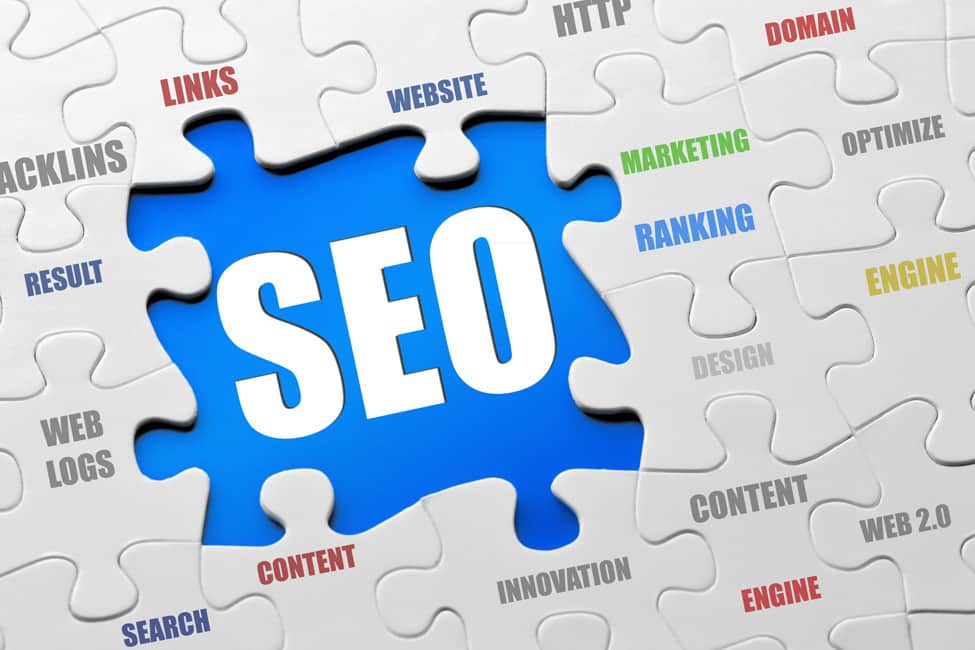
What can SEO do?
Search engine optimization not only brings more traffic to your website, but it also helps ensure that the leads you are bringing in are of a higher quality. The goal of digital marketing is to attract those who are right for your products or services, and SEO plays an important role in doing just that. By emphasizing certain keywords and topics within your content, you can work to reach those online who are most likely to be interested in your products or services.
Effectively, SEO may target different kinds of search, including image search, video search, academic search, news search, and industry-specific vertical search engines. As a fact, SEO differs from local search engine optimization in that the latter is focused on optimizing a business’ online presence so that its web pages will be displayed by search engines when a user enters a local search for its products or services. The former instead is more focused on national or international searches.
![]()
Current SEO techniques
Current search engine optimization focuses on techniques such as making sure that each web page has appropriate title tags and that the content is not low quality. High quality content should be original, authoritative, factual, grammatically correct, and engaging to users. Poorly edited articles with spelling and grammatical errors will be demoted by search engines.
Also important for SEO are the so called “off-page” strategies. Rather than examining just the webpage itself, modern search engines take into account other factors such as the number of links to a page. The more inbound links to a web page the higher it will rank in the search engines.
Building links can also be accomplished by sharing content across social media platforms, such as Facebook, LinkedIn, Twitter, Google+, Pinterest and YouTube. Content that has been extensively shared on social media is taken into consideration by search engines as an indication that it is of higher quality.

Current market shares of most popular search engines:
According to NetMarketShare, Google is still by far the dominant search engine provider, with approximately 73% of the search engine market.
Google – 72.47%
Baidu – 13.47%
Bing – 7.64%
Yahoo! – 4.74%
Yandex – 0.86%
Ask – 0.30%
DuckDuckGo – 0.22%
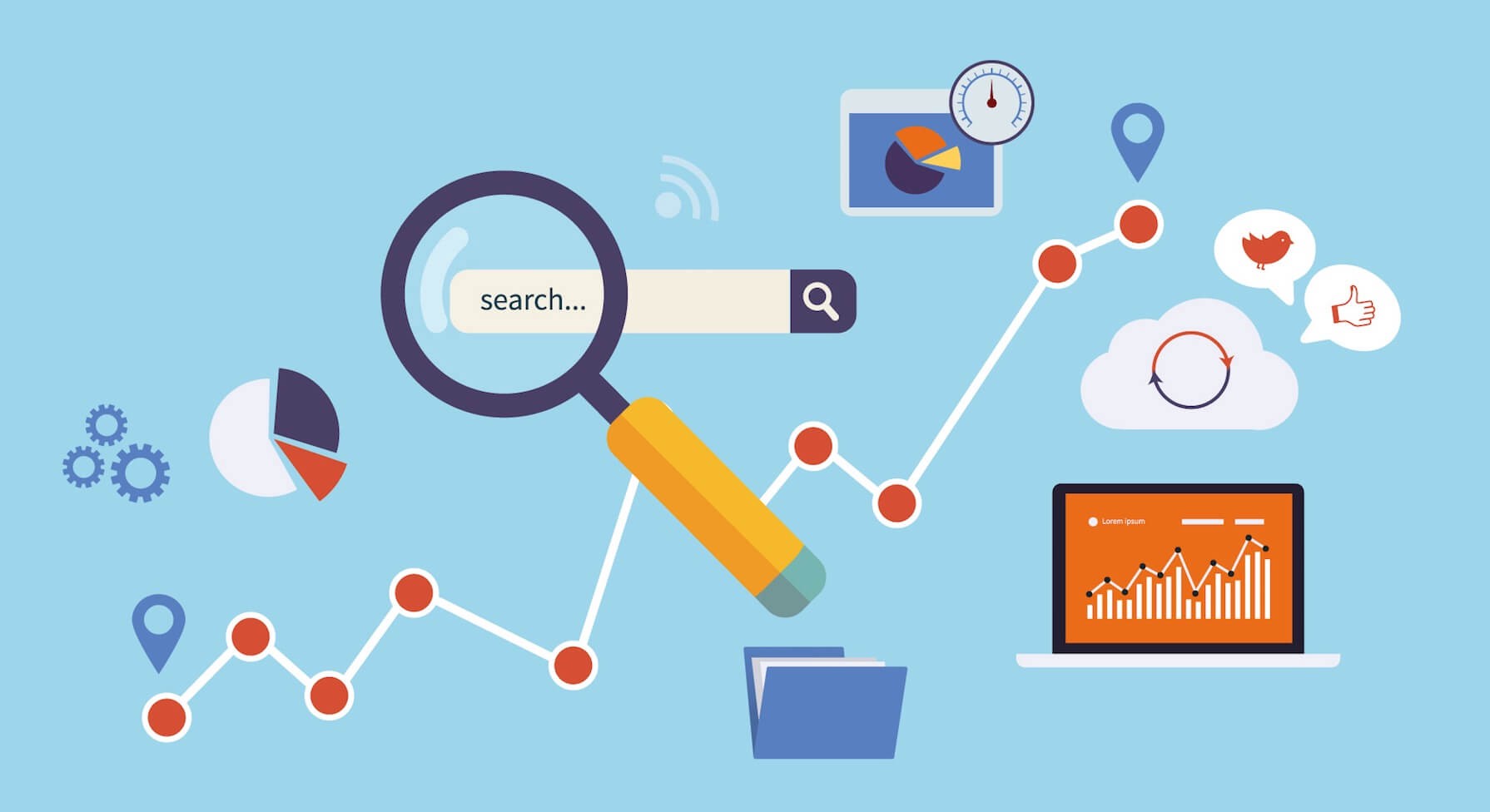
Blog #8: Influencer Marketing
What does it mean?
Influencer marketing is among the newer types of digital marketing. Influencer marketing uses people with an enormous online reach considered experts by your target market to drive traffic and sales.
Influencer marketing is popular on social media channels like Instagram and Snapchat. Companies hire famous Instagram users with large followings to promote their brand by posting one or more photos with the product. Companies now engage in Instagram or Snapchat “takeovers”, where the hired influence controls the company’s social media platform for a given amount of time, most often a day. These social media takeovers drive the influencer’s following to your social media channels increasing your new followers and unique views.
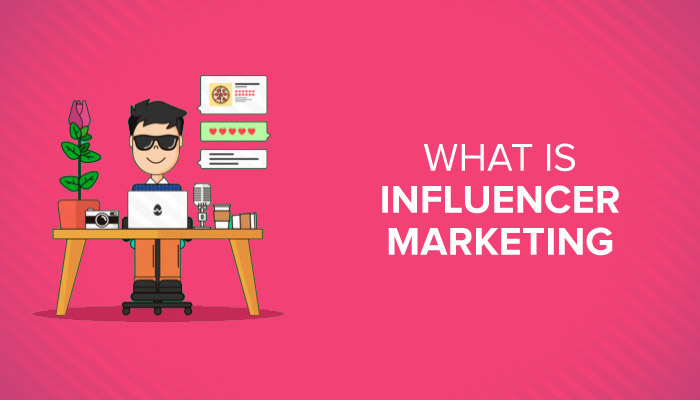
What you should do when starting an advertising campaign using influencer marketing
1. Start with a goal
Before you even begin to come up with a plan for your campaign, you need to define your goal. Whatever the goal may be, you should define it, and then use it as a basis for planning your campaign. Your goal will help you figure out which kinds of influencers to work with, and how you can best execute your campaign.
For example, if you want as many people as possible to hear about your brand, you should work with influencers who have massive reach. Have them tell your brand’s story in their own unique voices. Or if you want to drive engagement, look for micro-influencers who can reach a relevant and engaged audience. Have them promote a giveaway contest in which their followers can win free products or experiences from your business.

2.Find the right influencers
Absolutely, the influencers you choose should be relevant to both your brand, and your goal. Following are tips on how you should choose influencers to represent your brand and your product:
- Increase brand awareness:Top influencers with massive reach
- Boost brand sentiment: Influencers known for their honest and authentic content
- Build brand trust: Niche influencers known for creating authentic content
- Drive engagement:Relevant micro-influencers with high engagement rates
- Drive conversions:Mix of top, mid-level, and micro-influencers across various relevant niches
- Promote a product launch: Industry experts and niche influencers with significant reach
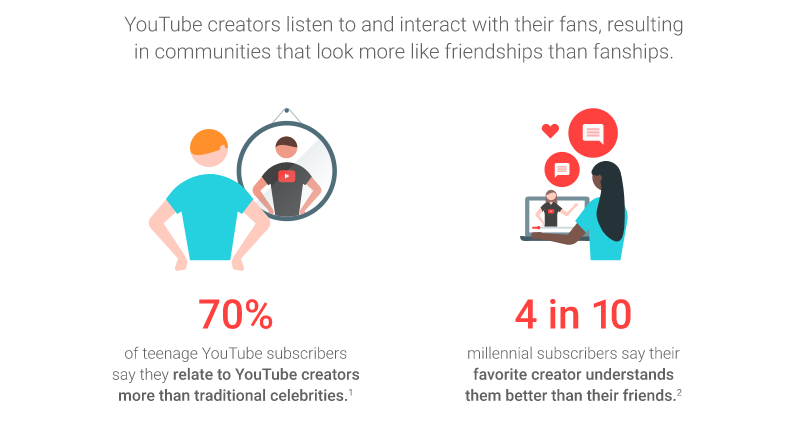
3. Provide sufficient compensation
One of the biggest mistakes you can make in influencer marketing is failing to provide your influencers with sufficient compensation. Influencers let you use their influence to reach a relevant audience. It’s only fair that you compensate them fairly for it.
Below are five compensation model that are most popular for influencer marketing:
- Cost per engagement: This is when you compensate influencers according to the number of engagements they drive with their content.
- Cost per click: With cost per click, you compensate influencers according to the number of clicks they drive to your landing page.
- Pay per post: With this model, you pay influencers a fixed amount for each post they create for your business.
- Free products/experiences: Instead of monetary compensation, you can offer influencers free products or experiences in exchange for their partnership.
- Cost per acquisition: you compensate influencers for the number of actions or acquisitions they drive.
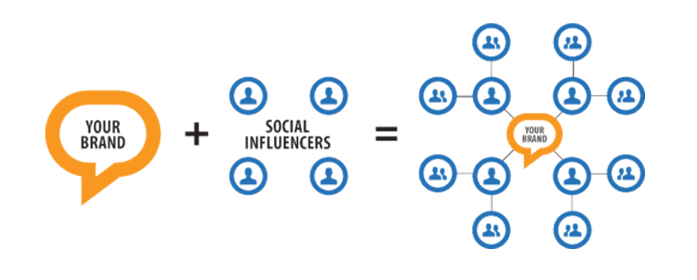
4. Plan your influencer marketing campaign
There are many different ways to run an influencer marketing campaign. You should choose the best type for your brand, based on your specific goals. Following are three of the most effective types of influencer marketing campaigns:
- Help influencers set up an Instagram storefront: if you plan on executing an Instagram influencer marketing campaign, have your influencers set up their own storefronts. Influencers can post photos of your products on Instagram, and include a link to their personal storefront in their bio. Their storefront will then include their images of your products, with links to each specific product page. Which helps make it as easy as possible for their followers to buy.
- Promote a giveaway contest: Giveaways can be a highly effective component of influencer marketing campaigns. They can help you engage your target audience, and raise more awareness about your business. When an influencer hosts a giveaway contest using your products, they get a chance to engage their followers, while at the same time driving engagement for your business.
- Have them create unique content: When you work with influencers, let them tell your brand’s story in their own voices. Trust them to create content that will engage their followers, and inspire them to check out your brand.

Blog #9: Viral Marketing
What is viral marketing?
Viral Marketing is that which is able to generate interest and the potential sale of a brand or product through messages that spread like a virus, in other words, quickly, and from person to person. The idea is for it to be the users themselves that choose to share the content.
Due to their speed and ease to share, social networks are the natural habitat of this kind of marketing. The most widespread example in recent times is the surprising or spectacular videos on YouTube, which are then shared on Facebook, Twitter and other channels.
The reason to make use or virality, the ease in spreading and sharing, is however a double-edged sword. We cannot forget that in this type of campaign, a large part of the control falls into the hands of the users, and we risk the message being misinterpreted or parodied. On the other hand, a successful viral campaign can work miracles for your brand’s results.

How a viral campaign works
A viral marketing campaign is very simple to be done: create a video or another type of content which is attractive to the target, put it on the internet and plan the first actions to get it moving. Form there on, all you can do is wait for the fuse to light and for users to start sharing rapidly.
In some cases, virality happens by accident, from a video uploaded by a private user that all of a sudden becomes popular and begins to circulate all around the Internet.
As for the dispersion strategy of the videos created by brands, we have two focus points: the shown or the concealed. In the former, the user is aware from the first moment that they are viewing advertising content, while in the latter the participation of the brand is hidden and is only revealed later.
If you apply concealed marketing techniques, it is important to be very careful so the user does not feel tricked, cheated or deceived, as the viral campaign could then turn against you.
No matter what strategy we choose, we should never ever become spammers, nor go overboard while sharing the content. Instead of repeating message over and over again, the best strategy is to find the perfect place and time and let the “viral fuse” light itself.

Advantages of viral marketing
- Low cost: the users do a significant part of the work for us, which drastically cuts down the costs of dispersion.
- Potential of great reach. A viral video on the Internet has the ability to reach a huge international audience without us having to invest money or make any extra effort.
- It is not invasive. In viral marketing, the decision to participate and share always comes from the user, and so it never comes across as invasive.
- It helps build up your brand. If you can create content so incredible that users themselves decide to share it, it will also then create a personal connection with your brand. It is without a doubt an extremely powerful tool when it comes to branding and awareness.
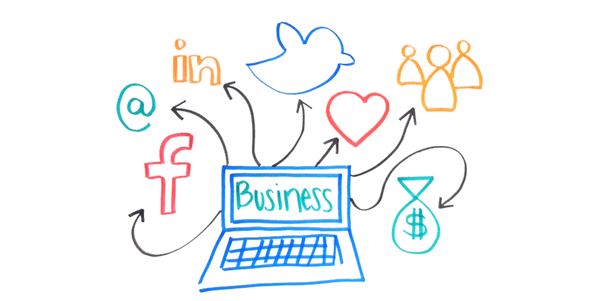
Blog #10: Mobile Advertising
What is mobile phone advertising?
Mobile advertising is the communication of products or services to mobile device and smartphone consumers. The mobile advertising spectrum ranges from short message service (SMS) text to interactive advertisements.
Mobile marketing is the art of marketing your business to appeal to mobile device users. When done right, mobile marketing provides customers or potential customers using smartphones with personalized, time- and location-sensitive information so that they can get what they need exactly when they need it, even if they’re on the go.
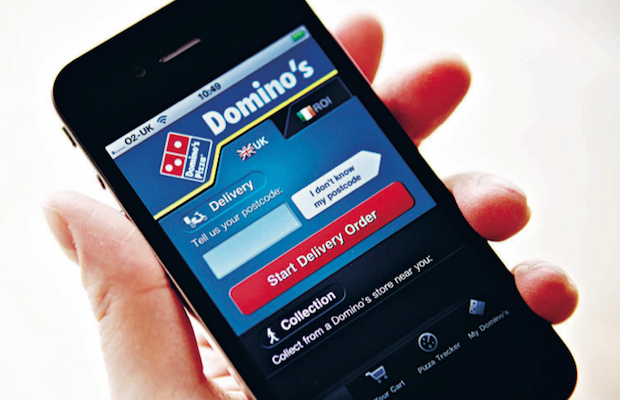
How Does Mobile Marketing Work?
Mobile marketing consists of ads that appear on mobile smartphones, tablets, or other mobile devices. Mobile marketing ad formats, customization, and styles can vary, as many social media platforms, websites, and mobile apps offer their own unique and tailored mobile ad options.

Types of Mobile Marketing Strategies
There’s a variety of mobile marketing strategies to try for your marketing campaign. The kind that works best for your business will depend on your industry, target audience, and budget. Following are a few types of mobile marketing strategies:
- App-based marketing: This is mobile advertising involving mobile apps.
- In game mobile marketing: In game mobile marketing refers to mobile ads that appear within mobile games. In game ads can appear as banner pop-ups, full-page image ads, or even video ads that appear between loading screens.
- QR codes: QR codes are scanned by users, who are then taken to a specific webpage that the QR code is attached to.
- Location-based marketing: Location-based mobile ads are ads that appear on mobile devices based upon a user’s location relative to a specific area or business.
- Mobile image ads: Image-based ads designed to appear on mobile devices.
- SMS: SMS marketing involves capturing a user’s phone number and sending them text offers.
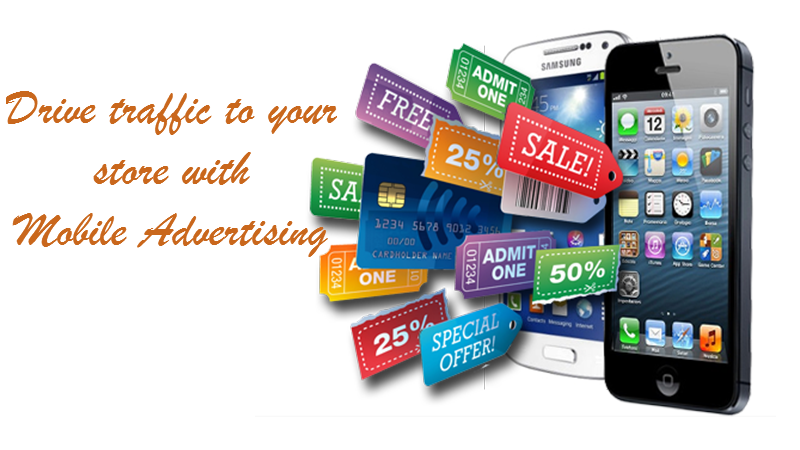
Best practices of mobile marketing:
1. Be Clear and Concise: Mobile devices have small screens, which means words should be used sparingly. Cluttered and crowded ads will just drive users to scroll past. When it comes to mobile, it’s best to keep things simple.
2. Optimize for Local: Users often use mobile devices to complement their immediate worldly interactions Optimize for local mobile marketing to make sure you are aligning with users’ needs.
3. Consider Your Audience: The type of audience you’re hoping to reach should influence the kind of mobile ads you use
4. Benchmark Your Results: It is always good to track your results to see what works and what doesn’t.

